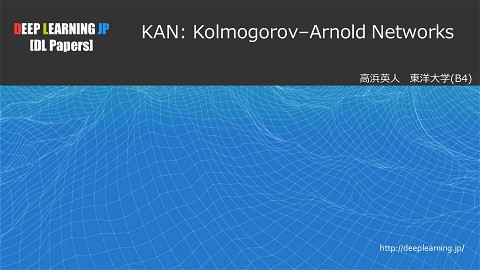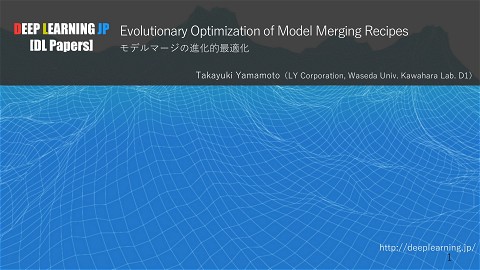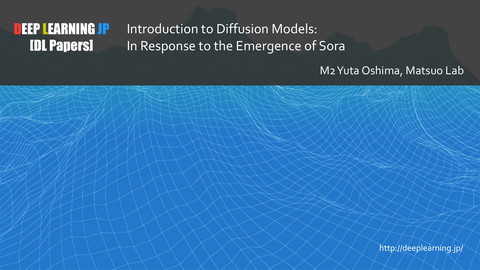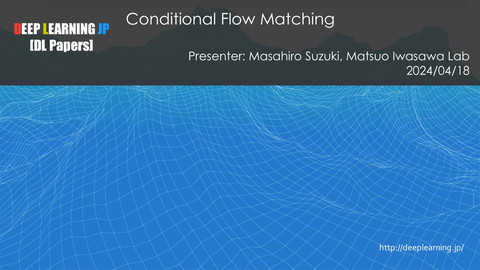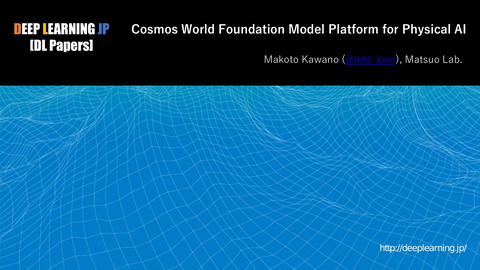[DL輪読会]Focal Loss for Dense Object Detection
346 Views
February 08, 18
スライド概要
Deep Learning JP:
http://deeplearning.jp/seminar-2/
DL輪読会資料
関連スライド
各ページのテキスト
DEEP LEARNING JP [DL Papers] “Focal Loss for Dense Object Detection (ICCV 2017)” 土居健人, 岩崎研 http://deeplearning.jp/ 1
書誌情報 • ICCV2017 Student Best Paper • 著者: T.Lin, P. Goyal, R. Girshick, K. He, P. Dolla ́r – 物体検出でおなじみのR. Girshick氏とK. He氏の名も • 引用数: 2017年は56 • 選定理由 – – – – シンプルな手法で大きな成果をあげた クラスの不均衡の問題に興味があった 分類や領域分割など他のタスクにも適用できそう 最近Facebookの研究グループがDetectronを公開したのでタイムリー • 注釈の無い図は本論文からの引用 2
論文概要 • 物体検出タスクにおいてone-stage detectorの精度を高めたい – one-stage detector (YOLO, SSDなど) – two-stage detector (Faster R-CNN系) • 学習時のクラスの不均衡がone-stage detectorの検出精度に悪影 響を与えることを指摘 – 物体 (positive) << 背景 (negative) – 背景(hard negative) << 背景(easy negative) • クラスの不均衡を調整するためFocal Lossという損失関数を提案し, one-stage detector(ReinaNet)でCOCOデータセットのsotaを達成. 3
※kawanoさんのYOLO9000の発表資料から引用 J. Redmon (2017) 4
One-stage detectors • 一段のCNNで直接bounding box の座標とクラスを推定する • 代表的なモデルはYOLO, SSD • two-stage detectorに比べると, 検出速度が速く,精度は劣る J. Redmon (2016) 5
Two-stage detector • 以下の2段階のプロセスで物体検出をする手法 – ①候補領域の抽出 – ②クラス,bounding boxの座標の推定 • 代表的なモデルはFaster R-CNN • 検出精度が高いが,速度がやや遅い S. Ren (2016) 6
speed/accuracy trade-off (J. Huang 2017) 7
本論文の仮説 仮説 クラスの不均衡がone-stage detectorの検出精度に悪影響を与えている. one-stage detector • 膨大な数(~100k)の抽出領域のほと んどがeasy negative example positive example hard negative easy negative • 学習にあまり役立たないサンプルの数 が圧倒的になってしまっている. • two-stage detectorではこのような不均 衡は起こっていない. ※フリー素材 8
不均衡データ問題への対策 目標 クラスの不均衡の解決によりone-stage detectorの性能を上げる 先行研究 • boostrapping • hard example mining – 学習に寄与するデータのみサンプリングする. 提案手法 • 新たな損失関数 (Focal Loss) 9
Focal Loss • αt : クラス間の重み付け • (1-pt)γ : easy exampleをdown-weight 実装が簡単!! 10
実験 データセット • COCO benchmark RetinaNet • ResNetベース • subnetでbounding box, クラス推定 • 各ピクセルごとに領域を抽出 11
Focal Lossの効果 • Focal Lossの最適なパラメータの探索 – α = 0.25 – γ = 2.0 ➢Focal Lossの適用により精度が向上 ➢最適なαとγの探索が必要 12
OHEMとの比較 • Online Hard Example Mining (OHEM) との比較 – OHEMは学習時にhard exampleをサン プリングする手法 • OHEMよりも良い結果になった – 筆者はeasy negativeを全く学習に使わ ないのはよく無いのではと考察 13
easy negativeの損失の低減 • 累積分布関数により各抽出領域の損失への寄与を可視化. • γ=2において負例の損失のほとんどがhard exampleからなるこ とがわかる. 14
ベンチマークとの比較① • two-stageの検出器の精度を上回り,state of the art. 15
ベンチマークとの比較② • 速さ,精度ともに優れている. 16
まとめ • 学習時のクラス不均衡がone-stage detectorの性能を下げて いることを発見. • 不均衡に対処するためにFocal Lossを提案. • COCOベンチマークで検証し,既存の手法を速度と精度の両 方で上回った. 17
感想 • シンプルな手法で大きな成果を上げていてすごい. • 各ピクセルごとに領域を抽出するRetinaNetはFocal Lossと相 性が良さそう. – 大量に無駄な領域を抽出してもFocal Lossで調整できる. • 分類やセグメンテーションなど他のタスクにも応用できそう – X. Zhou et al. Focal FCN: Towards Small Object Segmentation with Limited Training Data, arXiv, 2017. – 多クラス問題の場合,超パラメータの探索が課題 18
参考文献 T. Lin et al. Focal Loss for Dense Object Detection. In ICCV, 2017. J. Redmon and A. Farhadi. YOLO9000: Better, faster, stronger. In CVPR, 2017. J. Redmon, S. Divvala, R. Girshick, and A. Farhadi. You only look once: Unified, real-time object detection. In CVPR, 2016. S. Ren, K. He, R. Girshick, and J. Sun. Faster R-CNN: To- wards real-time object detection with region proposal net- works. In NIPS, 2015. J. Huang, V. Rathod, C. Sun, M. Zhu, A. Korattikara, A. Fathi, I. Fischer, Z.Wojna, Y. Song, S. Guadarrama, and K. Murphy. Speed/accuracy trade-offs for modern convolu- tional object detectors. 2017. X. Zhou et al. Focal FCN: Towards Small Object Segmentation with Limited Training Data. arXiv, 2017. 19

